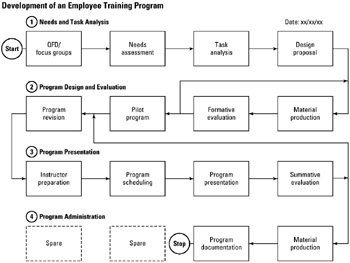Tool 18: Block Diagram
| AKA | Function Block Diagram |
| Classification | Analyzing/Trending (AT) |
Tool description
The block diagram illustrates, at an overview level, how a process flows from function to function or from unit to unit within an organization. The diagram uses blocks to reflect the most important activities and links them together by connecting lines that represent material or communication flows.
Typical application
-
To provide a high-level view of a process.
-
To promote an understanding of process function and sequence.
-
To identify cross-functional unit interfacing.
Problem-solving phase
| Select and define problem or opportunity | |
| → | Identify and analyze causes or potential change |
| → | Develop and plan possible solutions or change |
| → | Implement and evaluate solution or change |
| Measure and report solution or change results | |
| Recognize and reward team efforts |
Typically used by
| Research/statistics | |
| Creativity/innovation | |
| 5 | Engineering |
| 1 | Project management |
| Manufacturing | |
| 4 | Marketing/sales |
| 3 | Administration/documentation |
| Servicing/support | |
| 2 | Customer/quality metrics |
| Change management |
before
-
Process analysis
-
Work flow analysis (WFA)
-
Problem analysis
-
Work breakdown structure (WBS)
-
Systems Analysis Diagram
after
-
Organization Chart
-
Process Mapping
-
Potential problem analysis (PPA)
-
Functional Map
-
Activity analysis
Notes and key points
![]()
Step-by-step procedure
-
STEP 1 The team identifies all functions or activities within a process and checks where the start and stop functions are, as determined by team consensus. See example Development of an Employee Training Program.
-
STEP 2 The functions are sequenced and drawn on a whiteboard or flip charts in a block diagram format.
-
STEP 3 The team verifies that all blocks (functions) are accounted for and drawn in the proper sequence to accurately reflect the current process.
-
STEP 4 Finally, additional supporting information is added and the diagram is dated, as shown in the example.
Example of tool application

EAN: 2147483647
Pages: 326